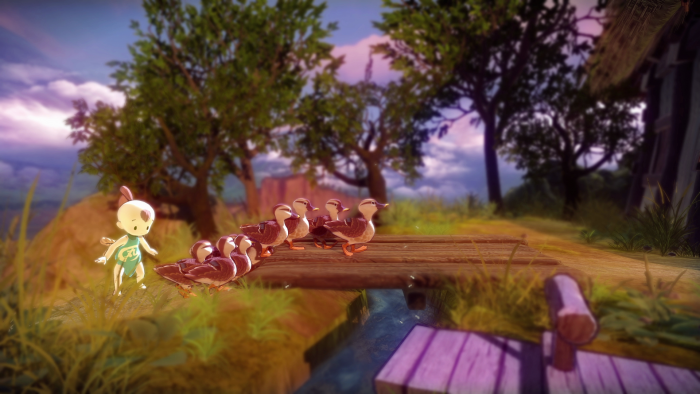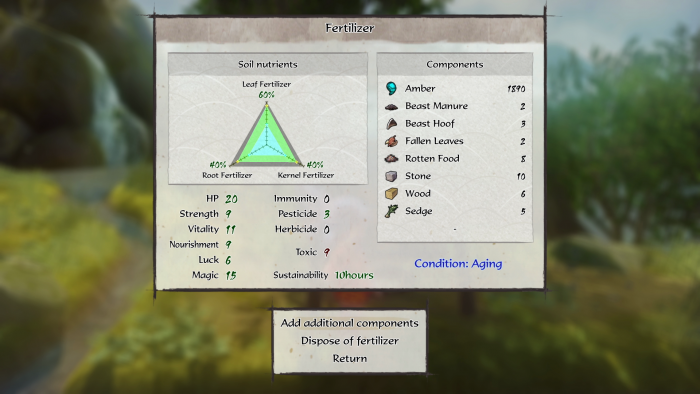Sakuna of Rice and Ruin is a very obvious passion project by Edelweiss, the two-man indie developer based in Japan. Without even knowing who the two of them are while playing through Sakuna I was able to distinctly pick out who did what in each of the game’s drastically different gameplay styles. There’s a natural push and pull between the two that Sakuna tries to evoke with its themes and gameplay, but there are some speed bumps along the way that cause the game to slowly wither and lose some of its original charm.
You play as Sakuna, a 1,000 year old goddess who happens to love drinking but is also in the body of a child. She’s almost stereotypically that one character in every Disney movie that starts out being kind of the bad guy but then by the time the credits roll they have a change of heart. She’s the glue of the game, bringing together a cast of human characters who get banished from the heavens for indulging on too much rice. And they need to atone for their sin by… growing the best rice on an island inhabited by demons that only a goddess can kill.

Sakuna of Rice and Ruin mixes together two forms of gameplay. One is a 2D side scrolling beat-em-up and the other is Farming Simulator 2020: Rice edition. The 2D part functions pretty much like the baby of Street Fighter Third Strike and Marvel vs Capcom 2 and relies almost entirely on you learning combos and knowing how to cancel animations during fights. You’re gonna die a lot if you don’t, bottom line. These levels function as areas for you to grind while acquiring materials to use back at your farm. Each level has a checklist of things to accomplish like obtaining X item or killing X thing 10 times.

There are intricate levels of detail involved in the farming aspects of Sakuna. When planting rice you have to be precise in coordinating how far apart they are and where they’re placed while the controls are a weird mishmash of being tank-like and inverting your camera in a first person shooter. It’s hard, but naturally it will get easier through experience and skills you unlock. After planting happens you need to make sure that the water levels are right up to your ankle. Each day you need to drain it and fill it up manually, but also don’t forget to pick those bugs up and also don’t forget the weeds and make sure the water isn’t too cold or too high or too hot or hey did I mention fertilizer? People have to poop of course, so you’ll need to scoop the poop from the outhouse on your land and then place it in a tank to make fertilizer and add ingredients to them to increase aspects of the rice and soil that goes on to increase the value and rating of certain stats of Sakuna at the end of the year when you offer it to the rice goddess and — whew!

There are so many intricate details in the farming section of the game that you can easily get lost in the numbers, and min max the hell out of everything if you wanted to. Each day will consist of you tending to your rice, going out to fight something or acquiring a material you need for one of the million things to do back on the homestead. You’re restricted by the hours in the day so you need to know exactly what you need to do or you’ll inevitably end up wasting time. I could go on and on about the many systems in the game but I’ll save you the trouble.

The main cast of human characters is small but they all offer something of importance for Sakuna to improve the produce and life of the homestead. Tauemon helps around the farm, Kinta makes new weapons, Myrthe is a cook, Yul likes to sew clothes and the baby Kaimaru is a duck wrangler. Days on the farm function in three day seasons, from spring to fall you will be focused on planting, tending and developing the rice.
Sakuna of Rice and Ruin walks a very fine line between being exactly what I want in a game and what I dislike, literally combining two of my favorite genres into one. It’s an over indulgent action farming simulation game executed by two guys who clearly have a passion and talent for the granularities they’ve put into it, but also isn’t able to nail the landing to its minimal story and never pushes the very interesting gameplay mechanics beyond what’s initially introduced. I wanted to love the game and recommend it to everyone I knew because of its idiosyncrasies but I feel that it can only find a home with a player who plays the niche types of games that rarely get translated for the States. The price point is probably more than what most are willing to give on top of all this. BUT if you’ve thought to yourself, “hey I like weirdo games that are off the beaten path and I like beating dudes up and farming” then you might want to check this one out — eventually.
This review is based on a code sent to SideQuesting by the publisher.



No Comments